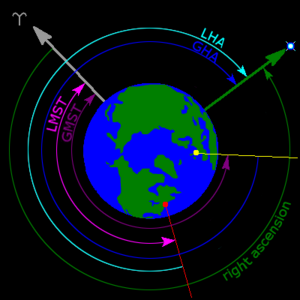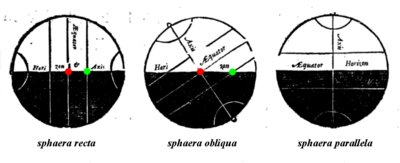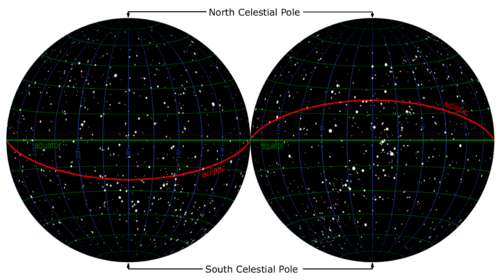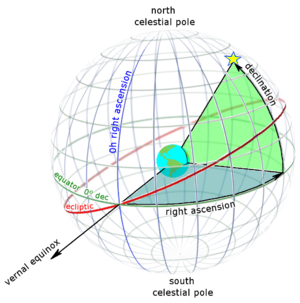صعود مستقيم

المطلع المستقيم في علم الفلك هو البعد الزاوي لجرم سماوي عن نقطة أول الاعتدال الربيعي ويقاس هذا بوحدات الوقت على اعتبار أن الدائرة السماوية التي تحيط بالأرض عند خط الإستواء السماوي مقسمة إلى 24 ساعة وكل ساعة مقسمة إلى 60 دقيقة وكل دقيقة إلى 60 ثانية وتبدأ الساعة الأولى في هذا النظام مع أول برج الحمل وتنتهي الساعة 24 مع نهاية برج الحوت واختصار المطلع المستقيم هو م . م باللغه العربيـــة و إنگليزية: Right ascension R.A.
. . . . . . . . . . . . . . . . . . . . . . . . . . . . . . . . . . . . . . . . . . . . . . . . . . . . . . . . . . . . . . . . . . . . . . . . . . . . . . . . . . . . . . . . . . . . . . . . . . . . . . . . . . . . . . . . . . . . . . . . . . . . . . . . . . . . . . . . . . . . . . . . . . . . . . . . . . . . . . . . . . . . . . . .
الشرح

Assuming the day of the year is the March equinox: the Sun lies toward the grey arrow, the star marked by a green arrow will appear to rise somewhere in the east about midnight (the Earth drawn from "above" turns anticlockwise). After the observer reaches the green arrow, dawn will over-power (see blue sky Rayleigh scattering) the star's light for about six hours, before it sets on the western horizon. The Right ascension of the star is about 18h. 18h means it is a March early-hours star and in blue sky in the morning. If 12h RA, the star would be a March all-night star as opposite the March equinox. If 6h RA the star would be a March late-hours star, at its high (meridian) at dusk.
Right ascension is the celestial equivalent of terrestrial longitude. Both right ascension and longitude measure an angle from a primary direction (a zero point) on an equator. Right ascension is measured from the Sun at the March equinox i.e. the First Point of Aries, which is the place on the celestial sphere where the Sun crosses the celestial equator from south to north at the March equinox and is currently located in the constellation Pisces. Right ascension is measured continuously in a full circle from that alignment of Earth and Sun in space, that equinox, the measurement increasing towards the east.[1]
As seen from Earth (except at the poles), objects noted to have 12h RA are longest visible (appear throughout the night) at the March equinox; those with 0h RA (apart from the sun) do so at the September equinox. On those dates at midnight, such objects will reach ("culminate" at) their highest point (their meridian). How high depends on their declination; if 0° declination (i.e. on the celestial equator) then at Earth's equator they are directly overhead (at zenith).
Any units of angular measure could have been chosen for right ascension, but it is customarily measured in hours (h), minutes (m), and seconds (s), with 24h being equivalent to a full circle. Astronomers have chosen this unit to measure right ascension because they measure a star's location by timing its passage through the highest point in the sky as the Earth rotates. The line which passes through the highest point in the sky, called the meridian, is the projection of a longitude line onto the celestial sphere. Since a complete circle contains 24h of right ascension or 360° (degrees of arc), 1/24 of a circle is measured as 1h of right ascension, or 15°; 1/1440 of a circle is measured as 1m of right ascension, or 15 minutes of arc (also written as 15′); and 1/86400 of a circle contains 1s of right ascension, or 15 seconds of arc (also written as 15″). A full circle, measured in right-ascension units, contains 24 × 60 × 60 = 86400s, or 24 × 60 = 1440m, or 24h.[2]
Because right ascensions are measured in hours (of rotation of the Earth), they can be used to time the positions of objects in the sky. For example, if a star with RA = 1h 30m 00s is at its meridian, then a star with RA = 20h 00m 00s will be on the/at its meridian (at its apparent highest point) 18.5 sidereal hours later.
Sidereal hour angle, used in celestial navigation, is similar to right ascension but increases westward rather than eastward. Usually measured in degrees (°), it is the complement of right ascension with respect to 24h.[3] It is important not to confuse sidereal hour angle with the astronomical concept of hour angle, which measures the angular distance of an object westward from the local meridian.
Symbols and abbreviations
| Unit | Value | Symbol | Sexagesimal system | In radians |
|---|---|---|---|---|
| Hour | 1/24 circle | h | 15° | π/12 rad |
| Minute | 1/60 hour, 1/1440 circle | m | 1/4°, 15′ | π/720 rad |
| Second | 1/60 minute, 1/3600 hour, 1/86400 circle | s | 1/240°, 1/4′, 15″ | π/43200 rad |
Effects of precession
مثال على المطلع المستقيم
إن نجم العيوق مطلعه المستقيم هو 5 ساعـــات و 16 دقيقة و 26 ثانيه ومعنى ذلك أن العيوق يشرق بعد شروق أول الإعتدال الربيعى بهذا الوقت.
التاريخ

The concept of right ascension has been known at least as far back as Hipparchus who measured stars in equatorial coordinates in the 2nd century BC. But Hipparchus and his successors made their star catalogs in ecliptic coordinates, and the use of RA was limited to special cases.
With the invention of the telescope, it became possible for astronomers to observe celestial objects in greater detail, provided that the telescope could be kept pointed at the object for a period of time. The easiest way to do that is to use an equatorial mount, which allows the telescope to be aligned with one of its two pivots parallel to the Earth's axis. A motorized clock drive often is used with an equatorial mount to cancel out the Earth's rotation. As the equatorial mount became widely adopted for observation, the equatorial coordinate system, which includes right ascension, was adopted at the same time for simplicity. Equatorial mounts could then be accurately pointed at objects with known right ascension and declination by the use of setting circles. The first star catalog to use right ascension and declination was John Flamsteed's Historia Coelestis Britannica (1712, 1725).

انظر أيضاً
ملاحظات ومراجع
- ^ Moulton, Forest Ray (1916). An Introduction to Astronomy. Macmillan Co., New York. pp. 125–126.
- ^ Moulton (1916), p. 126.
- ^ Explanatory Supplement (1992), p. 11.
- ^ Blaeu (1668), p. 40–41.
وصلات خارجية
- MEASURING THE SKY A Quick Guide to the Celestial Sphere James B. Kaler, University of Illinois
- Celestial Equatorial Coordinate System University of Nebraska-Lincoln
- Celestial Equatorial Coordinate Explorers University of Nebraska-Lincoln
- Merrifield, Michael. "(α,δ) – Right Ascension & Declination". Sixty Symbols. Brady Haran for the University of Nottingham.
- Sidereal pointer (Torquetum) – to determine RA/DEC.
